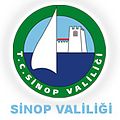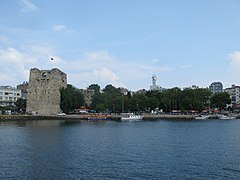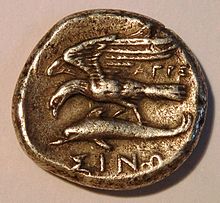Sinop
| Sinop | ||||
|
||||
 Sinop from above |
||||
| Basic data | ||||
|---|---|---|---|---|
| Province (il) : | Sinop | |||
| Coordinates : | 42 ° 2 ' N , 35 ° 9' E | |||
| Residents : | 54,260 (2019) | |||
| Telephone code : | (+90) 368 | |||
| Postal code : | 57,000 | |||
| License plate : | 57 | |||
| Structure and administration (as of 2019) | ||||
| Structure : | 13 Mahalle | |||
| Mayor : | Barış Ayhan ( CHP ) | |||
| Postal address : | Meydankapı Mahallesi, Ataturk Cd. No: 8 57000 Sinop |
|||
| Website: | ||||
| Sinop County | ||||
| Residents : | 65,845 (2019) | |||
| Surface: | 442 km² | |||
| Population density : | 149 inhabitants per km² | |||
Sinop ( ancient Greek Σινώπη Sinope , German Sinope ), port city and seaside resort on the Black Sea , is the capital of the Turkish province of Sinop in northern Anatolia . Sinop is also the center of a district that reports directly to the governor, the central district ( Merkez ).
geography
Sinop is the northernmost district town of Anatolia and is about 300 kilometers (as the crow flies) northeast of Ankara. The city is affected by the Black Sea coast road (D010) and has its own airport.
The central district ( Merkez ) is also the northernmost district of Anatolia and borders the Erfelek district in the west, the Boyabat district in the south and the Gerze district in the southeast. It is the most populous in the province and, in addition to the district town, consists of 38 villages ( Köy ) with an average of 308 inhabitants. Abalı (960), Dibekli (776) and Demirci (668) are the largest, 15 villages have more than 308 (= average) inhabitants. Four former villages ( Bostancılı , Korucuk , Ordu and Osmaniye ) became districts ( mahalle ) of Sinop in 2018 .
With a population density of 146 inhabitants per km², the district is four times the provincial value, the urban population is 81.86 percent.
Climate table
| Sinop | ||||||||||||||||||||||||||||||||||||||||||||||||
|---|---|---|---|---|---|---|---|---|---|---|---|---|---|---|---|---|---|---|---|---|---|---|---|---|---|---|---|---|---|---|---|---|---|---|---|---|---|---|---|---|---|---|---|---|---|---|---|---|
| Climate diagram | ||||||||||||||||||||||||||||||||||||||||||||||||
| ||||||||||||||||||||||||||||||||||||||||||||||||
|
Average monthly temperatures and rainfall for Sinop
|
||||||||||||||||||||||||||||||||||||||||||||||||||||||||||||||||||||||||||||||||||||||||||||||||||||||||||||||||||||||||||||||||||||||||||||||||||||||
Population development
The following table shows the comparative population level at the end of the year for the province, the central district and the city of Sinop as well as the respective share at the higher administrative level. The figures are based on the address-based population register (ADNKS) introduced in 2007.
| year | province | district | city | ||
|---|---|---|---|---|---|
| absolutely | proportionally (%) | absolutely | proportionally (%) | absolutely | |
| 2018 | 219.733 | 29.37 | 64,544 | 81.86 | 52,837 |
| 2017 | 207,427 | 30.47 | 63.205 | 66.83 | 42,242 |
| 2016 | 205,478 | 30.03 | 61,708 | 67.07 | 41,386 |
| 2015 | 204.133 | 29.82 | 60,880 | 66.80 | 40,667 |
| 2014 | 204,526 | 29.13 | 59,571 | 65.87 | 39,239 |
| 2013 | 204,568 | 28.35 | 58.005 | 66.30 | 38,459 |
| 2012 | 201.311 | 28.51 | 57,399 | 67.20 | 38,571 |
| 2011 | 203.027 | 27.93 | 56,711 | 68.25 | 38,705 |
| 2010 | 202.740 | 27.47 | 55,686 | 67.72 | 37,708 |
| 2009 | 201.134 | 27.37 | 55.056 | 66.72 | 36,734 |
| 2008 | 200,791 | 26.69 | 53,584 | 66.05 | 35,393 |
| 2007 | 198.412 | 26.54 | 52,667 | 65.99 | 34,755 |
Census results
The following population information about the city, the district, the province and the country is available for the censuses:
| region | 1965 | 1970 | 1975 | 1980 | 1985 | 1990 | 2000 |
|---|---|---|---|---|---|---|---|
| City (Şehir) | 13,354 | 15.096 | 16,098 | 18,328 | 23,148 | 25,537 | 30.502 |
| central circle (Merkez) | 38,663 | 37,979 | 39,056 | 42,745 | 47,437 | 49,844 | 49,839 |
| Province (İl) | 266,069 | 265,655 | 267,605 | 276.242 | 280.140 | 265.153 | 225,574 |
| Turkey | 31,391,421 | 35.605.176 | 40,347,719 | 44,736,957 | 50,664,458 | 56.473.035 | 67,803,927 |
history
Sinope has played an important role as a cultural and commercial center on the Black Sea for several millennia. The oldest traces of human settlement date from the Bronze Age . Sinope was an early Black Sea colony of on the west coast of Asia Minor lying Greek city of Miletus . The oldest archaeological evidence of Greek settlement dates from the late seventh century BC. BC, which goes well with Eusebius' founding date 631 BC. Chr. Fits. The authenticity of a much earlier first foundation before the middle of the eighth century BC BC, which some ancient authors mention ( Pseudo-Skymnos , indirectly Strabo ), is controversial in modern research.
According to these reports, the Thessalians Autolycus, Deileon and Phlogios settled there after they had taken part in a campaign against the Amazons . A little later, before the arrival of the Cimmerians (see below), the Milesians Abrondas founded a new company. A very early first establishment is confirmed by a position at Strabo, in which it is said that Autolykos was venerated as the city founder in Sinope and that Miletus did not re-establish it until later. If the early first founding date were to apply, Sinope would be the oldest Greek colony in the Black Sea region. In the seventh century BC BC, Cimmerians who lived around 700 BC Were invaded in Asia Minor, among other things "in the area around Sinope" down. They are said to have expelled the early Greek colonists. A Cimmerian grave, which proves the presence of the Cimmerians in this area, was discovered a few years ago south of Sinop. After the Cimmerians were driven out by the Lydians in the last third of the seventh century, Milesians settled (again?) .
Sinope became one of the most important colonies, and many more colonies along the Black Sea coast - including Amisos (today's Samsun ), Kerasous ( Giresun ), and Trapezous ( Trabzon ) - were founded from Sinope, which made it very important in itself . Sinope often had the nymph Sinope on the obverse and a sea eagle over a dolphin on the reverse on its coins.
183 BC Pharnakes I conquered Sinope and made it the capital of the kingdom of Pontus . After the defeat of the Pontic king Mithridates VI. 64 BC BC against the Roman general Pompeius Magnus , the Romans incorporated Pontus into their empire, and Sinopes' influence decreased. Julius Caesar founded in 46 BC A colony in Sinope.
After the Seljuks conquered the city in 1214, the city regained importance and belonged to the Ottoman Empire from 1458 . After the devastating naval battle of Lepanto in 1571, the Ottoman Sultan Selim II had several hundred ships built in Sinope for the empire's fleet . For this, workers from all over the Ottoman Empire were brought to Sinope, many of whom settled in the region. Like the Greeks ( Pontic Greeks ), Circassians , Georgians , Bulgarians and Turks, they contributed to the cultural diversity.
On November 30, 1853, shortly after the outbreak of the Crimean War , the Russian Black Sea Fleet , under Vice Admiral Nakhimov , attacked the Ottoman port of Sinope with high explosive shells and set all ships there on fire. Large parts of the city burned down. The event has become known as the sea battle at Sinope .
Significance for art history
The production of chalk from the area around Sinope was of great importance for preliminary drawings in painting, especially for fresco painting of the Italian Renaissance . The painters obtained a special ocher-colored chalk from Sinope with which they made sketches and preliminary drawings. The pigment and the drawings so produced are Sinopia or sinopia known (see. The Sinopienmuseum in Pisa ).
In Sinop there is the Balatlar Church from the seventh century.
Personalities
- Diogenes (around 400–323 BC), Cynical philosopher
- Diphilus (poet) (around 355 BC - after 289 BC), Greek poet of the new comedy
- Mithridates VI. (132–63 BC), king of Pontus
- Marcion (before 100–160 AD), Christian theologian
- Phocas of Sinope († 117 or 303), Christian saint
- Rıza Nur (1879–1942), politician
- Necmettin Erbakan (1926–2011), former Prime Minister
- Hakan Ünsal (* 1973), soccer player
- Hasan Özdemir (* 1964), soccer player and coach
literature
- Askold I. Ivantchik: The establishment of Sinope and the problems of the initial phase of the Greek colonization of the Black Sea area. In: Gocha R. Tsetskhladze (Ed.): The Greek Colonization of the Black Sea Area. Historical Interpretation of Archeology (= Historia . Individual writings. Vol. 121). Steiner, Stuttgart 1998, ISBN 3-515-07302-7 , pp. 297-330.
Web links
Individual evidence
- ↑ a b Türkiye Nüfusu İl ilçe Mahalle Köy Nüfusları , accessed on April 13, 2020
- ↑ Central Dissemination System / Merkezi Dağıtım Sistemi (MEDAS) of the TÜIK , accessed on July 19, 2019
- ↑ Genel Nüfus Sayımları - İllere göre ilçe, bucak, belde ve köy nufusları (census results 1965 to 2000) , accessed on July 19, 2019
- ↑ Ekrem Akurgal - Ludwig Budde : Preliminary report on the excavations in Sinope. Türk Tarih Kurumu Basımevi, Ankara 1956.
- ↑ Skymnos 941-952.
- ^ Strabo, Geography XII 3.11.
- ↑ Herodotus, Historien 4,12,2.





